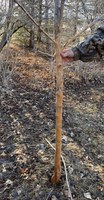Dakota Gardener: A little nudge
(Click an image below to view a high-resolution image that can be downloaded)
By Joe Zeleznik, Forester
NDSU Extension
As far as I’m concerned, it’s been a gorgeous fall.
The trees put on a great color show and then dropped their leaves in showers of yellow, red, gold and orange.
Around here, they’re mostly yellow.
Some of the lilacs were a bit weird, though. They flowered or sent out some small leaves. It was just a few shrubs, but they shouldn’t be blooming in the fall.
This year’s wet weather created perfect conditions for a foliar fungus called Pseudocercospora. Lilacs around the state got hammered by this disease. The shrubs lost their leaves early and went into a dormant state. When moderate fall temperatures arrived, some of them flowered.
Bizarre.
To help the lilacs, all we can do at this point is rake and destroy the leaves as best we can. We can hope that next year will be drier, but that one’s out of our hands.
Trees and shrubs usually prepare themselves for winter just fine. They store up energy in late summer and fall, and gradually harden off for winter.
But we can help here, too. Watering conifers late into the fall helps them get hydrated. That’s important for minimizing “winter injury.”
Winter injury can have a number of causes and isn’t understood very well. Nevertheless, getting trees hydrated before winter is key to managing this issue.
Late-fall watering isn’t as critical for the deciduous trees as it is for the conifers.
Perhaps the most important winter prep I do relates to my archenemies: rabbits.
Rabbits – and voles – kill more trees each winter than cold temperatures do. The animals eat the bark off of younger trees, especially fruit trees, to get to the sugar-rich phloem tissue just below the bark.
If a tree loses bark all the way around its circumference, it’s as good as dead. I’ve lost a number of apple trees over the years, and I’ve begun to take some extreme measures.
White plastic pipes and wraps do a good job of preventing this type of damage, but only as high as the pipe goes up the stem. When there’s a lot of snow, those pests climb the drifts and girdle the branches. What took years to develop can be gone in one season.
It’s frustrating.
I’ve now taken to putting a wire fence around my apple trees. It’s a bit of a project to set this up, but the fence is really effective against rabbits … as long as there are no major snow drifts. And if I set up the fence far enough from the tree trunk, the deer will be held back, too.
I’ll do what I can and hope for the best. I can’t control nature. The best I can do is try to give it a little nudge.
NDSU Agriculture Communication – Nov. 12, 2025
Source: Joe Zeleznik, 701-231-8143, joseph.zeleznik@ndsu.edu
Editor: Dominic Erickson, 701-231-5546, dominic.erickson@ndsu.edu




